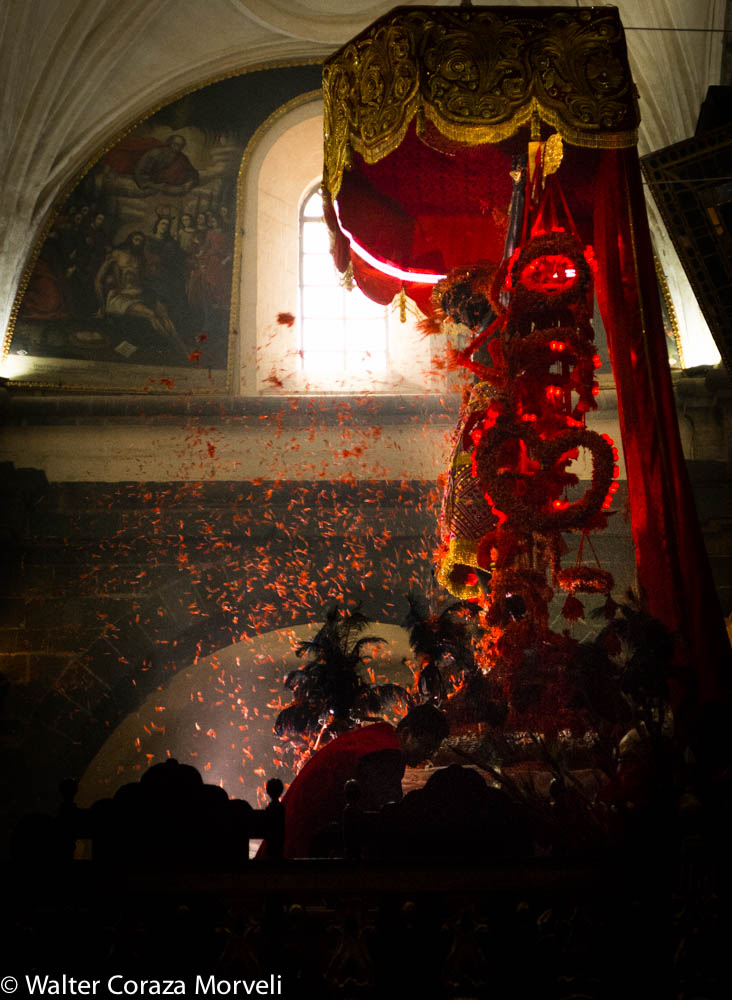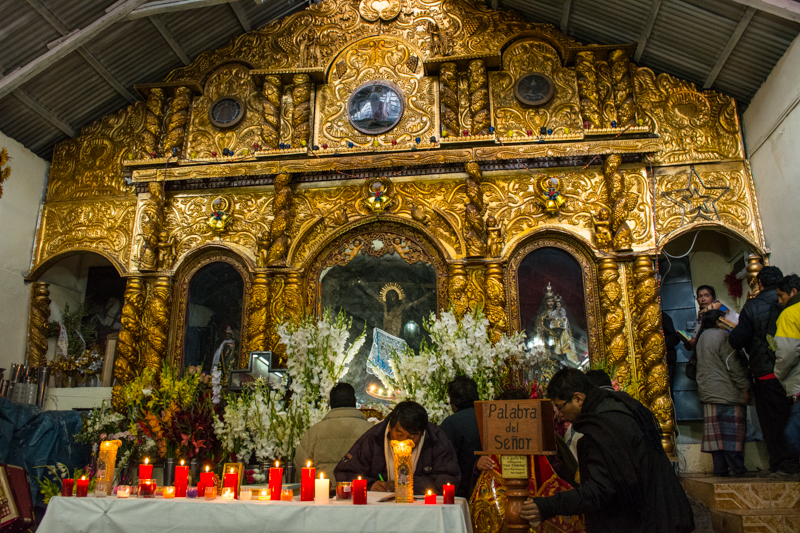Cusco’s People Express Passionate Devotion Today

The first time I saw Cusco’s patron, the Lord of Temblors, come out through the Cathedral door, swaying gently from side to side, I was overwhelmed.
A light rain fell. Bands played. The great, disturbing bell Maria Angola, deep and dissonant, sounded. Sirens shrieked.
The atrium of the Cathedral filled with people, many organized into groups of devotees according to brotherhoods and sisterhoods, the organizations that bring the city together.
The Lord slowly made his way on his bearers shoulders as if elegantly dancing a careful and slow step. He was covered with red flowers. These were not the rose petals one sees offered to virgins and saints, they were native flowers, ñuqch’u, a bright red sage flower. Ropes of them hung from him and many dropped off as if he were dripping blood.
He came out and began a procession, turning left at the Cathedral’s door to slowly dance around one side of the Plaza by balconies decorated with cloth and filled with people, before turning up Plateros street.

Hours later, as dusk arrived, I saw him again coming down Marquez street, bright in the darkening light and surrounded by followers intensely involved in every second, every step, as they had been throughout the afternoon. He had stopped along the way, for a change of clothes and for different groups of devotees to take turns bearing him and caring for him.
I followed behind as he entered into the main square, the Plaza de Armas, into a space more crowded than I had ever seen it. The Plaza and all the side streets were filled with, as they say, medio Cusco, half of Cusco, although it felt like Cusco entero, all of Cusco.
Everyone who could made their way to the Plaza. Although they may not have participated in the procession, earlier in the day, they came for this final moment called “su bendición”, his blessing. The earlier events had been organized by the sodalities, the brotherhoods and sisterhoods, the groups that are organized in every parish he visited. People showed their devotion to each other and to the Lord. Others joined on the edges and in the streets to throw flowers, pick up the dropped ones like little miracles to take home, and to see and feel.

His every movement and step were noted and commented on, mined for meaning in hope and faith, as the figure, a transcendent being who stayed with them, processed through the streets animated by his people and their faith. He lives with them and for them, although the stories of the Church connect him with the eternal God above. Nevertheless, his relationship with the people of Cusco is intimate and lives not just in all the movement of people and groups around him, but in the hopes and prayers, the desires and petitions, people make to him, the intimate and revealing parts of themselves they share with him and, maybe, no one else.
At night, when he reaches the Church’s door and to great noise, he turns before going in and dips as if nodding good bye to the massed people of Cusco. You can feel the emotion. The feeling races through the crowd. It is tangible and sensible when people’s depths and hopes connect with this Holy figure as he leaves their space and goes back inside the Church for another year.
This is not only the time of the Lord of Temblors, whose importance can only with difficulty be overstated, it is also a time when people have go to and return from Qoyllurrit’i. Here, different from the Blessing, there has been much conversation about whether people were going or not. For weeks people have asked each other, have given and received advice and council, and have told stories of going and of the effects of the pilgrimage.
The organized Nations, or in the case of Cusco, the organized groups that form the Nation of Tawantinsuyo, go. Their time on the Mountain is the culmination of a year’s work of activity and commitment. Known as the Shining or Starry Snow, or as the Christ of Qoyllurrit’i, for the image painted on a crag below the glacier whose name Jesus takes, in an act of superposition or attachment classic in Catholicism, the shrine draws dancers groups from the City of Cusco, its department, and from far away, at the same time it is a major tourist draw.
The pilgrimage also pulls ordinary people who make it in the night. They up the mountain by themselves, or in small groups, for their own reasons. Along the way they meet and talk, sharing experiences and hopes, as well as advice and concerns. At the top, they “play” at being married, owning houses, obtaining the goods and statuses of social life that they do not have below but that they desire. They model their desires and share with others so that theirs might become materialized in reality.

Then they come down the mountain, being careful not to slip and fall on the often icy or muddy path. You will see the organized brotherhoods that form part of the Nation return to Cusco in costume, but you will not be aware of seeing the thousands who went on their own, or with family and friends, as they now return to the sacred middle, the Main Square before the Cathedral to seek the blessing of the Lord before he enters his cavernous dwelling. From high in the sky, they return with their petitions and feelings, their hopes expressed to the divine.
These two moments in Holy Week, the pilgrimage to the mountain and to the Plaza to accompany the Lord or just to receive his blessing are a social and ritual heart that pump life and activity into the society, while bringing it value. They make it live in all the individuals of Cusco. Their power stays with me, even when I am far away.




